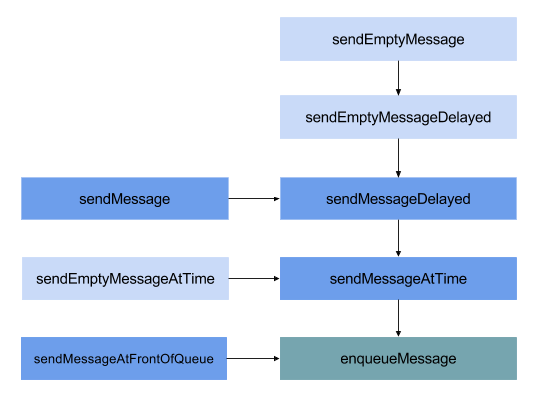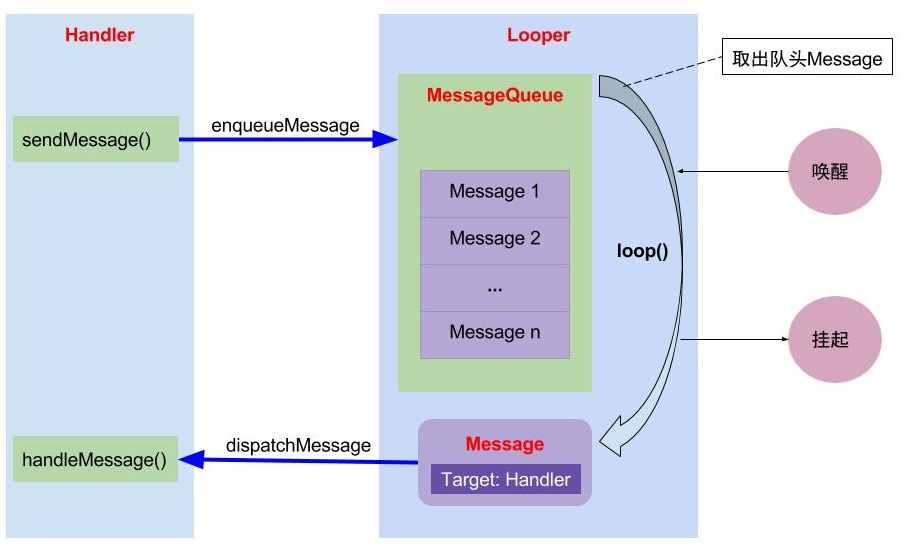标签:防止 工作 flags front 产生 int thread 主循环 handler
转自:http://gityuan.com/2015/12/26/handler-message-framework/
相关源码
framework/base/core/java/andorid/os/Handler.java
framework/base/core/java/andorid/os/Looper.java
framework/base/core/java/andorid/os/Message.java
framework/base/core/java/andorid/os/MessageQueue.java
libcore/luni/src/main/java/java/lang/ThreadLocal.java
在整个Android的源码世界里,有两大利剑,其一是Binder IPC机制,,另一个便是消息机制(由Handler/Looper/MessageQueue等构成的)。关于Binder在Binder系列中详细讲解过,有兴趣看看。
Android有大量的消息驱动方式来进行交互,比如Android的四剑客Activity, Service, Broadcast, ContentProvider的启动过程的交互,都离不开消息机制,Android某种意义上也可以说成是一个以消息驱动的系统。消息机制涉及MessageQueue/Message/Looper/Handler这4个类。
消息机制主要包含:
MessageQueue.enqueueMessage)和取走消息池的消息(MessageQueue.next);Handler.sendMessage)和处理相应消息事件(Handler.handleMessage);Looper.loop),按分发机制将消息分发给目标处理者。
先展示一个典型的关于Handler/Looper的线程
class LooperThread extends Thread {
public Handler mHandler;
public void run() {
Looper.prepare(); //【见 2.1】
mHandler = new Handler() { //【见 3.1】
public void handleMessage(Message msg) {
//TODO 定义消息处理逻辑. 【见 3.2】
}
};
Looper.loop(); //【见 2.2】
}
}
接下来,围绕着这个实例展开详细分析。
对于无参的情况,默认调用prepare(true),表示的是这个Looper运行退出,而对于false的情况则表示当前Looper不运行退出。
private static void prepare(boolean quitAllowed) {
//每个线程只允许执行一次该方法,第二次执行时线程的TLS已有数据,则会抛出异常。
if (sThreadLocal.get() != null) {
throw new RuntimeException("Only one Looper may be created per thread");
}
//创建Looper对象,并保存到当前线程的TLS区域
sThreadLocal.set(new Looper(quitAllowed));
}
这里的sThreadLocal是ThreadLocal类型,下面,先说说ThreadLocal。
ThreadLocal: 线程本地存储区(Thread Local Storage,简称为TLS),每个线程都有自己的私有的本地存储区域,不同线程之间彼此不能访问对方的TLS区域。TLS常用的操作方法:
ThreadLocal.set(T value):将value存储到当前线程的TLS区域,源码如下:
public void set(T value) {
Thread currentThread = Thread.currentThread(); //获取当前线程
Values values = values(currentThread); //查找当前线程的本地储存区
if (values == null) {
//当线程本地存储区,尚未存储该线程相关信息时,则创建Values对象
values = initializeValues(currentThread);
}
//保存数据value到当前线程this
values.put(this, value);
}
ThreadLocal.get():获取当前线程TLS区域的数据,源码如下:
public T get() {
Thread currentThread = Thread.currentThread(); //获取当前线程
Values values = values(currentThread); //查找当前线程的本地储存区
if (values != null) {
Object[] table = values.table;
int index = hash & values.mask;
if (this.reference == table[index]) {
return (T) table[index + 1]; //返回当前线程储存区中的数据
}
} else {
//创建Values对象
values = initializeValues(currentThread);
}
return (T) values.getAfterMiss(this); //从目标线程存储区没有查询是则返回null
}
ThreadLocal的get()和set()方法操作的类型都是泛型,接着回到前面提到的sThreadLocal变量,其定义如下:
static final ThreadLocal<Looper> sThreadLocal = new ThreadLocal<Looper>()
可见sThreadLocal的get()和set()操作的类型都是Looper类型。
Looper.prepare()
Looper.prepare()在每个线程只允许执行一次,该方法会创建Looper对象,Looper的构造方法中会创建一个MessageQueue对象,再将Looper对象保存到当前线程TLS。
对于Looper类型的构造方法如下:
private Looper(boolean quitAllowed) {
mQueue = new MessageQueue(quitAllowed); //创建MessageQueue对象. 【见4.1】
mThread = Thread.currentThread(); //记录当前线程.
}
另外,与prepare()相近功能的,还有一个prepareMainLooper()方法,该方法主要在ActivityThread类中使用。
public static void prepareMainLooper() {
prepare(false); //设置不允许退出的Looper
synchronized (Looper.class) {
//将当前的Looper保存为主Looper,每个线程只允许执行一次。
if (sMainLooper != null) {
throw new IllegalStateException("The main Looper has already been prepared.");
}
sMainLooper = myLooper();
}
}
public static void loop() {
final Looper me = myLooper(); //获取TLS存储的Looper对象 【见2.4】
if (me == null) {
throw new RuntimeException("No Looper; Looper.prepare() wasn‘t called on this thread.");
}
final MessageQueue queue = me.mQueue; //获取Looper对象中的消息队列
Binder.clearCallingIdentity();
//确保在权限检查时基于本地进程,而不是基于最初调用进程。
final long ident = Binder.clearCallingIdentity();
for (;;) { //进入loop的主循环方法
Message msg = queue.next(); //可能会阻塞 【见4.2】
if (msg == null) { //没有消息,则退出循环
return;
}
Printer logging = me.mLogging; //默认为null,可通过setMessageLogging()方法来指定输出,用于debug功能
if (logging != null) {
logging.println(">>>>> Dispatching to " + msg.target + " " +
msg.callback + ": " + msg.what);
}
msg.target.dispatchMessage(msg); //用于分发Message 【见3.2】
if (logging != null) {
logging.println("<<<<< Finished to " + msg.target + " " + msg.callback);
}
final long newIdent = Binder.clearCallingIdentity(); //确保分发过程中identity不会损坏
if (ident != newIdent) {
//打印identity改变的log,在分发消息过程中是不希望身份被改变的。
}
msg.recycleUnchecked(); //将Message放入消息池 【见5.2】
}
}
loop()进入循环模式,不断重复下面的操作,直到没有消息时退出循环
这是这个消息处理的核心部分。另外,上面代码中可以看到有logging方法,这是用于debug的,默认情况下logging == null,通过设置setMessageLogging()用来开启debug工作。
public void quit() {
mQueue.quit(false); //消息移除
}
public void quitSafely() {
mQueue.quit(true); //安全地消息移除
}
Looper.quit()方法的实现最终调用的是MessageQueue.quit()方法
MessageQueue.quit()
void quit(boolean safe) {
// 当mQuitAllowed为false,表示不运行退出,强行调用quit()会抛出异常
if (!mQuitAllowed) {
throw new IllegalStateException("Main thread not allowed to quit.");
}
synchronized (this) {
if (mQuitting) { //防止多次执行退出操作
return;
}
mQuitting = true;
if (safe) {
removeAllFutureMessagesLocked(); //移除尚未触发的所有消息
} else {
removeAllMessagesLocked(); //移除所有的消息
}
//mQuitting=false,那么认定为 mPtr != 0
nativeWake(mPtr);
}
}
消息退出的方式:
用于获取TLS存储的Looper对象
public static @Nullable Looper myLooper() {
return sThreadLocal.get();
}
发送消息,并设置消息的callback,用于处理消息。
public final boolean post(Runnable r)
{
return sendMessageDelayed(getPostMessage(r), 0);
}
private static Message getPostMessage(Runnable r) {
Message m = Message.obtain();
m.callback = r;
return m;
}
public Handler() {
this(null, false);
}
public Handler(Callback callback, boolean async) {
//匿名类、内部类或本地类都必须申明为static,否则会警告可能出现内存泄露
if (FIND_POTENTIAL_LEAKS) {
final Class<? extends Handler> klass = getClass();
if ((klass.isAnonymousClass() || klass.isMemberClass() || klass.isLocalClass()) &&
(klass.getModifiers() & Modifier.STATIC) == 0) {
Log.w(TAG, "The following Handler class should be static or leaks might occur: " +
klass.getCanonicalName());
}
}
//必须先执行Looper.prepare(),才能获取Looper对象,否则为null.
mLooper = Looper.myLooper(); //从当前线程的TLS中获取Looper对象【见2.1】
if (mLooper == null) {
throw new RuntimeException("");
}
mQueue = mLooper.mQueue; //消息队列,来自Looper对象
mCallback = callback; //回调方法
mAsynchronous = async; //设置消息是否为异步处理方式
}
对于Handler的无参构造方法,默认采用当前线程TLS中的Looper对象,并且callback回调方法为null,且消息为同步处理方式。只要执行的Looper.prepare()方法,那么便可以获取有效的Looper对象。
public Handler(Looper looper) {
this(looper, null, false);
}
public Handler(Looper looper, Callback callback, boolean async) {
mLooper = looper;
mQueue = looper.mQueue;
mCallback = callback;
mAsynchronous = async;
}
Handler类在构造方法中,可指定Looper,Callback回调方法以及消息的处理方式(同步或异步),对于无参的handler,默认是当前线程的Looper。
在Looper.loop()中,当发现有消息时,调用消息的目标handler,执行dispatchMessage()方法来分发消息。
public void dispatchMessage(Message msg) {
if (msg.callback != null) {
//当Message存在回调方法,回调msg.callback.run()方法;
handleCallback(msg);
} else {
if (mCallback != null) {
//当Handler存在Callback成员变量时,回调方法handleMessage();
if (mCallback.handleMessage(msg)) {
return;
}
}
//Handler自身的回调方法handleMessage()
handleMessage(msg);
}
}
分发消息流程:
Message的回调方法不为空时,则回调方法msg.callback.run(),其中callBack数据类型为Runnable,否则进入步骤2;Handler的mCallback成员变量不为空时,则回调方法mCallback.handleMessage(msg),否则进入步骤3;Handler自身的回调方法handleMessage(),该方法默认为空,Handler子类通过覆写该方法来完成具体的逻辑。对于很多情况下,消息分发后的处理方法是第3种情况,即Handler.handleMessage(),一般地往往通过覆写该方法从而实现自己的业务逻辑。
发送消息调用链:

从上图,可以发现所有的发消息方式,最终都是调用MessageQueue.enqueueMessage();
public final boolean sendEmptyMessage(int what)
{
return sendEmptyMessageDelayed(what, 0);
}
public final boolean sendEmptyMessageDelayed(int what, long delayMillis) {
Message msg = Message.obtain();
msg.what = what;
return sendMessageDelayed(msg, delayMillis);
}
public final boolean sendMessageDelayed(Message msg, long delayMillis)
{
if (delayMillis < 0) {
delayMillis = 0;
}
return sendMessageAtTime(msg, SystemClock.uptimeMillis() + delayMillis);
}
public boolean sendMessageAtTime(Message msg, long uptimeMillis) {
MessageQueue queue = mQueue;
if (queue == null) {
return false;
}
return enqueueMessage(queue, msg, uptimeMillis);
}
public final boolean sendMessageAtFrontOfQueue(Message msg) {
MessageQueue queue = mQueue;
if (queue == null) {
return false;
}
return enqueueMessage(queue, msg, 0);
}
该方法通过设置消息的触发时间为0,从而使Message加入到消息队列的队头。
public final boolean post(Runnable r)
{
return sendMessageDelayed(getPostMessage(r), 0);
}
private static Message getPostMessage(Runnable r) {
Message m = Message.obtain();
m.callback = r;
return m;
}
public final boolean postAtFrontOfQueue(Runnable r)
{
return sendMessageAtFrontOfQueue(getPostMessage(r));
}
private boolean enqueueMessage(MessageQueue queue, Message msg, long uptimeMillis) {
msg.target = this;
if (mAsynchronous) {
msg.setAsynchronous(true);
}
return queue.enqueueMessage(msg, uptimeMillis); 【见4.3】
}
Handler.sendEmptyMessage()等系列方法最终调用MessageQueue.enqueueMessage(msg, uptimeMillis),将消息添加到消息队列中,其中uptimeMillis为系统当前的运行时间,不包括休眠时间。
获取消息
public final Message obtainMessage()
{
return Message.obtain(this); 【见5.2】
}
Handler.obtainMessage()方法,最终调用Message.obtainMessage(this),其中this为当前的Handler对象。
public final void removeMessages(int what) {
mQueue.removeMessages(this, what, null); 【见 4.5】
}
Handler是消息机制中非常重要的辅助类,更多的实现都是MessageQueue, Message中的方法,Handler的目的是为了更加方便的使用消息机制。
MessageQueue是消息机制的Java层和C++层的连接纽带,大部分核心方法都交给native层来处理,其中MessageQueue类中涉及的native方法如下:
private native static long nativeInit();
private native static void nativeDestroy(long ptr);
private native void nativePollOnce(long ptr, int timeoutMillis);
private native static void nativeWake(long ptr);
private native static boolean nativeIsPolling(long ptr);
private native static void nativeSetFileDescriptorEvents(long ptr, int fd, int events);
关于这些native方法的介绍,见Android消息机制2-Handler(native篇)。
MessageQueue(boolean quitAllowed) {
mQuitAllowed = quitAllowed;
//通过native方法初始化消息队列,其中mPtr是供native代码使用
mPtr = nativeInit();
}
提取下一条message
Message next() {
final long ptr = mPtr;
if (ptr == 0) { //当消息循环已经退出,则直接返回
return null;
}
int pendingIdleHandlerCount = -1; // 循环迭代的首次为-1
int nextPollTimeoutMillis = 0;
for (;;) {
if (nextPollTimeoutMillis != 0) {
Binder.flushPendingCommands();
}
//阻塞操作,当等待nextPollTimeoutMillis时长,或者消息队列被唤醒,都会返回
nativePollOnce(ptr, nextPollTimeoutMillis);
synchronized (this) {
final long now = SystemClock.uptimeMillis();
Message prevMsg = null;
Message msg = mMessages;
if (msg != null && msg.target == null) {
//当消息Handler为空时,查询MessageQueue中的下一条异步消息msg,则退出循环。
do {
prevMsg = msg;
msg = msg.next;
} while (msg != null && !msg.isAsynchronous());
}
if (msg != null) {
if (now < msg.when) {
//当异步消息触发时间大于当前时间,则设置下一次轮询的超时时长
nextPollTimeoutMillis = (int) Math.min(msg.when - now, Integer.MAX_VALUE);
} else {
// 获取一条消息,并返回
mBlocked = false;
if (prevMsg != null) {
prevMsg.next = msg.next;
} else {
mMessages = msg.next;
}
msg.next = null;
//设置消息的使用状态,即flags |= FLAG_IN_USE
msg.markInUse();
return msg; //成功地获取MessageQueue中的下一条即将要执行的消息
}
} else {
//没有消息
nextPollTimeoutMillis = -1;
}
//消息正在退出,返回null
if (mQuitting) {
dispose();
return null;
}
//当消息队列为空,或者是消息队列的第一个消息时
if (pendingIdleHandlerCount < 0 && (mMessages == null || now < mMessages.when)) {
pendingIdleHandlerCount = mIdleHandlers.size();
}
if (pendingIdleHandlerCount <= 0) {
//没有idle handlers 需要运行,则循环并等待。
mBlocked = true;
continue;
}
if (mPendingIdleHandlers == null) {
mPendingIdleHandlers = new IdleHandler[Math.max(pendingIdleHandlerCount, 4)];
}
mPendingIdleHandlers = mIdleHandlers.toArray(mPendingIdleHandlers);
}
//只有第一次循环时,会运行idle handlers,执行完成后,重置pendingIdleHandlerCount为0.
for (int i = 0; i < pendingIdleHandlerCount; i++) {
final IdleHandler idler = mPendingIdleHandlers[i];
mPendingIdleHandlers[i] = null; //去掉handler的引用
boolean keep = false;
try {
keep = idler.queueIdle(); //idle时执行的方法
} catch (Throwable t) {
Log.wtf(TAG, "IdleHandler threw exception", t);
}
if (!keep) {
synchronized (this) {
mIdleHandlers.remove(idler);
}
}
}
//重置idle handler个数为0,以保证不会再次重复运行
pendingIdleHandlerCount = 0;
//当调用一个空闲handler时,一个新message能够被分发,因此无需等待可以直接查询pending message.
nextPollTimeoutMillis = 0;
}
}
nativePollOnce是阻塞操作,其中nextPollTimeoutMillis代表下一个消息到来前,还需要等待的时长;当nextPollTimeoutMillis = -1时,表示消息队列中无消息,会一直等待下去。
当处于空闲时,往往会执行IdleHandler中的方法。当nativePollOnce()返回后,next()从mMessages中提取一个消息。
nativePollOnce()在native做了大量的工作,想进一步了解可查看 Android消息机制2-Handler(native篇)。
添加一条消息到消息队列
boolean enqueueMessage(Message msg, long when) {
// 每一个Message必须有一个target
if (msg.target == null) {
throw new IllegalArgumentException("Message must have a target.");
}
if (msg.isInUse()) {
throw new IllegalStateException(msg + " This message is already in use.");
}
synchronized (this) {
if (mQuitting) { //正在退出时,回收msg,加入到消息池
msg.recycle();
return false;
}
msg.markInUse();
msg.when = when;
Message p = mMessages;
boolean needWake;
if (p == null || when == 0 || when < p.when) {
//p为null(代表MessageQueue没有消息) 或者msg的触发时间是队列中最早的, 则进入该该分支
msg.next = p;
mMessages = msg;
needWake = mBlocked; //当阻塞时需要唤醒
} else {
//将消息按时间顺序插入到MessageQueue。一般地,不需要唤醒事件队列,除非
//消息队头存在barrier,并且同时Message是队列中最早的异步消息。
needWake = mBlocked && p.target == null && msg.isAsynchronous();
Message prev;
for (;;) {
prev = p;
p = p.next;
if (p == null || when < p.when) {
break;
}
if (needWake && p.isAsynchronous()) {
needWake = false;
}
}
msg.next = p;
prev.next = msg;
}
//消息没有退出,我们认为此时mPtr != 0
if (needWake) {
nativeWake(mPtr);
}
}
return true;
}
MessageQueue是按照Message触发时间的先后顺序排列的,队头的消息是将要最早触发的消息。当有消息需要加入消息队列时,会从队列头开始遍历,直到找到消息应该插入的合适位置,以保证所有消息的时间顺序。
void removeMessages(Handler h, int what, Object object) {
if (h == null) {
return;
}
synchronized (this) {
Message p = mMessages;
//从消息队列的头部开始,移除所有符合条件的消息
while (p != null && p.target == h && p.what == what
&& (object == null || p.obj == object)) {
Message n = p.next;
mMessages = n;
p.recycleUnchecked();
p = n;
}
//移除剩余的符合要求的消息
while (p != null) {
Message n = p.next;
if (n != null) {
if (n.target == h && n.what == what
&& (object == null || n.obj == object)) {
Message nn = n.next;
n.recycleUnchecked();
p.next = nn;
continue;
}
}
p = n;
}
}
}
这个移除消息的方法,采用了两个while循环,第一个循环是从队头开始,移除符合条件的消息,第二个循环是从头部移除完连续的满足条件的消息之后,再从队列后面继续查询是否有满足条件的消息需要被移除。
每个消息用Message表示,Message主要包含以下内容:
| 数据类型 | 成员变量 | 解释 |
|---|---|---|
| int | what | 消息类别 |
| long | when | 消息触发时间 |
| int | arg1 | 参数1 |
| int | arg2 | 参数2 |
| Object | obj | 消息内容 |
| Handler | target | 消息响应方 |
| Runnable | callback | 回调方法 |
创建消息的过程,就是填充消息的上述内容的一项或多项。
在代码中,可能经常看到recycle()方法,咋一看,可能是在做虚拟机的gc()相关的工作,其实不然,这是用于把消息加入到消息池的作用。这样的好处是,当消息池不为空时,可以直接从消息池中获取Message对象,而不是直接创建,提高效率。
静态变量sPool的数据类型为Message,通过next成员变量,维护一个消息池;静态变量MAX_POOL_SIZE代表消息池的可用大小;消息池的默认大小为50。
消息池常用的操作方法是obtain()和recycle()。
从消息池中获取消息
public static Message obtain() {
synchronized (sPoolSync) {
if (sPool != null) {
Message m = sPool;
sPool = m.next;
m.next = null; //从sPool中取出一个Message对象,并消息链表断开
m.flags = 0; // 清除in-use flag
sPoolSize--; //消息池的可用大小进行减1操作
return m;
}
}
return new Message(); // 当消息池为空时,直接创建Message对象
}
obtain(),从消息池取Message,都是把消息池表头的Message取走,再把表头指向next;
把不再使用的消息加入消息池
public void recycle() {
if (isInUse()) { //判断消息是否正在使用
if (gCheckRecycle) { //Android 5.0以后的版本默认为true,之前的版本默认为false.
throw new IllegalStateException("This message cannot be recycled because it is still in use.");
}
return;
}
recycleUnchecked();
}
//对于不再使用的消息,加入到消息池
void recycleUnchecked() {
//将消息标示位置为IN_USE,并清空消息所有的参数。
flags = FLAG_IN_USE;
what = 0;
arg1 = 0;
arg2 = 0;
obj = null;
replyTo = null;
sendingUid = -1;
when = 0;
target = null;
callback = null;
data = null;
synchronized (sPoolSync) {
if (sPoolSize < MAX_POOL_SIZE) { //当消息池没有满时,将Message对象加入消息池
next = sPool;
sPool = this;
sPoolSize++; //消息池的可用大小进行加1操作
}
}
}
recycle(),将Message加入到消息池的过程,都是把Message加到链表的表头;
最后用一张图,来表示整个消息机制

图解:
消息分发的优先级:
message.callback.run(),优先级最高;Handler.mCallback.handleMessage(msg),优先级仅次于1;Handler.handleMessage(msg),优先级最低。Android消息机制1-Handler(Java层)(转)
标签:防止 工作 flags front 产生 int thread 主循环 handler
原文地址:http://www.cnblogs.com/zl1991/p/6862216.html